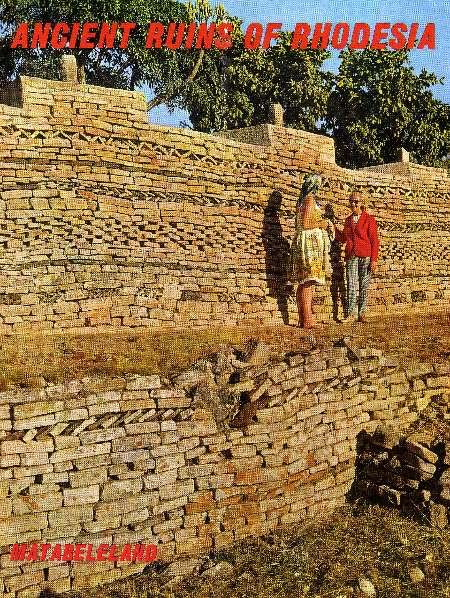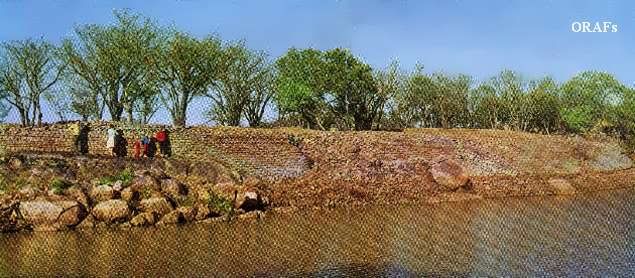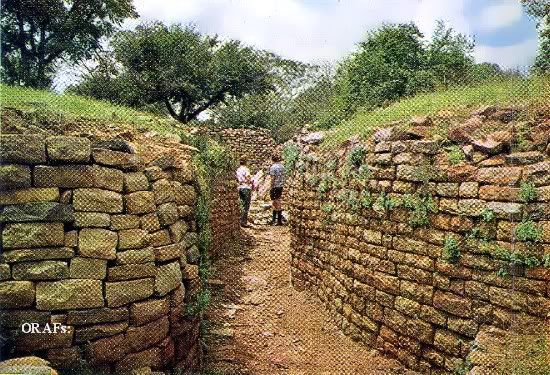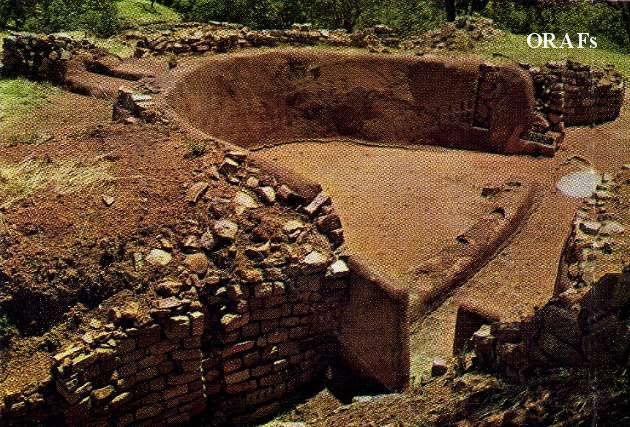Ancient Ruins of Rhodesia Matabeleland)
by C. K. COOKE, F.S.A.
Director, Historical Monuments Commission.

Above: The main wall of Naletale Ruins is the finest piece of decorated walling so far found in Rhodesia. The patterns include "herring-bone", chevron, chequer and lines of contrasting coloured stones.
THE southern half of Rhodesia (Matabeleland) can boast of four important ruined stone buildings each of which has unique features and all of which are National Monuments. Although they belong to the same complex as the well-known Zimbabwe Ruins, they each contain many features not found there: if Zimbabwe was the dwelling place of the paramount ruler, then each of these smaller ruins may be likened to manor houses, occupied by the lesser but very important chiefs under him.
Khami Ruins.
The most extensive of the four, these ruins are situated only 14 miles from Bulawayo. They cover many hundreds of acres but the most accessible and important are adjacent to the Khami Municipal Dam.
Lobengula used the main hill for rain-making ceremonies and in consequence denied access to all. Pre-Pioneer maps show the area as "The King's Preserve". Thus, the ruins remained unknown until after 1893, whereas Zimbabwe had been visited by white men many years before.
The Hill Ruin was the centre of religious and other ceremonies and also the dwelling place of the Mambo, or chief of the area. From the top of the hill other ruins can be seen set in park-like grounds surrounded by broken granite hills of great beauty.
The Historical Monuments Commission has carried out a number of archaeological investigations here, and many of the relics found will be on display in the Site Museum which is due to be opened to the public in September, 1966. Some of the other major ruins at Khami are illustrated on this page.
Dhlo Dhlo Ruins.
Sixty miles from Bulawayo, in the Fort Rixon district, are the ruins known as Dhlo Dhlo (pronounced Shlo Shlo). These compact ruins, situated in beautiful surroundings, can be easily reached in a motor-car, for more than half the distance is a full-width tar-road, and the remainder is well-graded gravel.

Above: The Precipice Ruin at Khami is a magnificent wall overlooking the impounded waters of the Khami Dam The breaches in the walls were probably made during the time when the buildings were sacked by Swazi invaders towards the end of the 18th Century.
Below: The compact Passage Ruin at Khami represents the complete living area of one family. The platforms flanking the passage had huts made of mud on them. Stone enclosures at the back were kraals for domesticated animals.


Above: A sunken stone-walled clay-plastered hut at Khami. This hut had a flat roof made of mud plastered over wooden beams. Divining-dice and other paraphernalia used by a "witch doctor"were found during excavations.
DHLO DHLO
Below: A beautifully decorated wall (at Dhlo Dhlo) against which was built an un-coursed wall of rough boulders. The enclosure was probably used as a cattle kraal by the last occupants of the site.

Above: A ruined wall on the top of a granite hill away from the main Dhlo Dhlo settlement. This wall shows a decorated enclosure similar to that at Regina. The plants in the foreground are "Aloe chabaudii".
Photo 3-2
REGINA
Below: The main ruin at Regina. A three-tiered building, it had huts on the second and top platform. Other smaller ruins surround this structure. Examples of the grotesque "Euphorbia ingens" can be seen on the lower platform.

Above: Foundations of huts and grainbins (at Regina) raised above ground level as a protection against termites and rodents. In the background is a high wall built in un-coursed masonry.
Below: A small decorated enclosure at Regina, probably a place where the Mambo, or chief of the area, sat in conference. Similar places are found in other ruins.
It was at this site that the ruling Mambo held captive a number of Portuguese prisoners. Relics left behind by the captives included a silver chalice, a priest's ring and part of a candlestick. These were recovered by early investigators.
The fenced area surrounding the ruins containing many shady trees, is a delightful place in which to picnic or camp.
The fenced area surrounding the ruins containing many shady trees, is a delightful place in which to picnic or camp.
Regina Ruins.
These should more properly be called Zinjanja and have only recently been cleared and opened to the public. It is believed that there the chief levied tributes of grain from his people. This grain — probably millet — was poured through stone-lined holes into chambers below. Some of these holes may still be seen intact; others were broken down by treasure-seekers many years ago. Other unusual features will be noted by the observant visitor.
These spectacular ruins — tiered like a wedding cake — are situated in well-watered open granite country about 18 miles from Dhlo Dhlo or 75 miles from Bulawayo if the direct
route is taken.
route is taken.
Naletale Ruins
Are situated on top of a granite hill overlooking the bleak open lands of the Somabula flats. The whole hill is covered with aloes (A. chubaudii and A. aculeata), whilst the Cabbage tree (Cussonia sp.) may be seen growing within the enclosures.
The main wall is outstanding both in building technique and in variety of pattern. The small square towers, each with its monolith, are very unusual in our ruins. The building was never completed; it was probably abandoned at the time the other structures were sacked by raiding Swazi impis.
Like jewels in individual settings, each ruin has a charm of its own; not only does the surrounding country vary, but each ruin has the stamp of its designer upon it. It can be said that all four ruins were built for the prestige of the resident chief: they thus have basic similarities, yet they differ greatly. Each site presented individual problems because of the variability of the terrain, the rock available for building, and the personal preferences of the ruler.


Published by Rhodesia National Tourist Board Printed in Rhodesia by Unitas Press, Salisbury.
End
Extracted and recompiled by Eddy Norris for use on "Our Rhodesian Heritage" blog
Publication was made available to ORAFs by Lewis Walter. Thank you Lewis
Acknowledgement and Appreciation
Paul Norris for the ISP sponsorship.
Paul Mroz for the image hosting sponsorship.
Robb Ellis for his assistance.
Should you wish to contact Eddy Norris please mail me on orafs11@gmail.com
Comments are always welcome, please send them to Eddy Norris at orafs11@gmail.com
Labels: Bembezi, Bulawayo, Daisyfield, Dhlo Dhlo Ruins, Fort Rixon, Insiza, Khami Ruins, Regina Ruins, Shangani



0 Comments:
Post a Comment
Subscribe to Post Comments [Atom]
<< Home